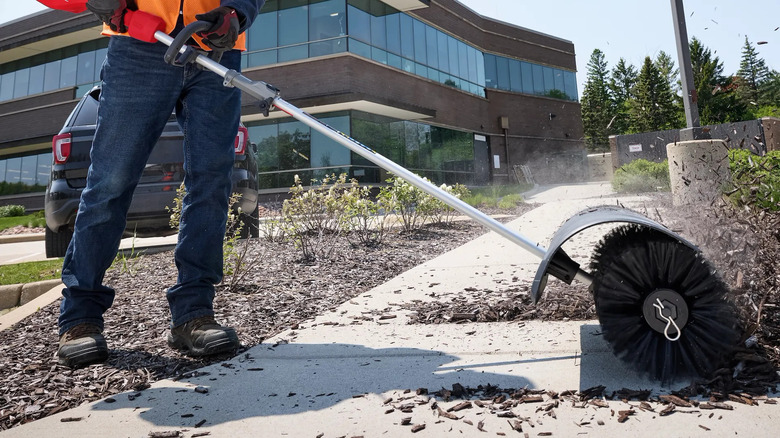Milwaukee Doesn't Make A Dethatcher, But You Can Use This Tool Instead
Part of maintaining a healthy lawn is knowing when and how to deal with the inevitable problem of thatch. Over time, a thick layer of dead grass, roots, and leaves accumulate all over your lawn as its organic residents go through their respective lifespans. This layer can settle between your plants and the actual soil, preventing them from properly absorbing nutrients and leaving your lawn unpleasantly patchy.
The solution is a dethatcher, which is a large, rake-like implement that can carve up and capture all that dead matter for easy disposal. A dethatcher is usually installed as a lawn mower attachment and pulled behind you. Unfortunately, not all lawn care and hardware brands offer this kind of tool. Milwaukee's Quik-Lok system, for example, has many interchangeable attachments like string trimmers and pole saws, but no dethatchers.
However, you may be able to perform some basic dethatching work with the help of one of the other attachments in the Quik-Lok system: the Milwaukee M18 Fuel Quik-Lok Bristle Brush. While not quite strong enough for a full-lawn dethatching job, this spinning Bristle Brush is robust enough to tear up some small patches of dead matter here and there.
The M18 Bristle Brush can handle some dethatching
The intended purpose of the Milwaukee M18 Fuel Quik-Lok Bristle Brush is to move debris that's piled up on hard surfaces like pavement and sidewalks. With rotational force from the Power Head of Milwaukee's M18 Fuel system, the Bristle Brush shovels up loose, sedimentary debris like mulch or gravel. If you put a little extra force into it, though, the rotation of the bristles can get down a little deeper into your lawn to remove piled up thatch.
The Bristle Brush is backed by a thick, curved guard plate that's meant to protect the user from kicked up materials. However, if you flip the attachment over, you could use this plate as an ersatz shovel, digging down into your lawn while the rotating bristles dig out the accumulated thatch. You have to remember that this isn't the way this tool is intended to be used, so your results may vary a bit. Since the guard wasn't designed as a shovel, for example, the bristles may not be able to penetrate into deep, heavily-accumulated thatch. Ultimately, if the thatch is too thick, you'll have to get a proper dethatcher to take it on. For quick, small jobs, though, the Bristle Brush may be able to handle it.

